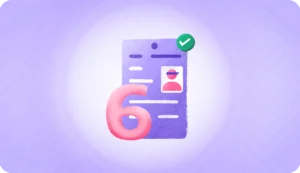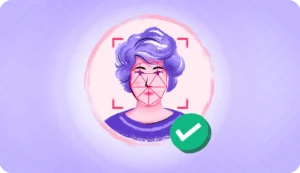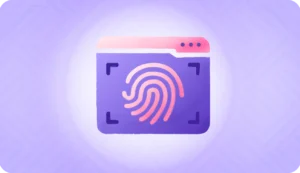As digital banking processes become more commonplace, the importance of our identity is growing. These procedures—such as online transactions and user onboarding—require identity confirmation to make sure that people are really who they say they are.
There are compliance regulations that mandate identity verification to protect both businesses and consumers. Know Your Customer (KYC) and Anti-Money Laundering (AML) regulations are constantly evolving. Businesses face a huge challenge in achieving global compliance, as each country has its own additional rules and identity verification regulations.
In this blog, we’ll cover the various identity verification methods used by enterprises today, including:
- Knowledge-based authentication
- Credit bureau-based authentication
- Two-factor authentication
- Biometric identity verification
- Database verification processes
- Online identity verification
Let’s look at each one in detail.
Types of Digital Identity Verification Methods
In digital identity verification, an individual’s ‘personally identifiable information’ is matched with authoritative data sources, such as utility bills, credit reports, and education records. Identity verification goes a long way in fraud prevention.
The instances of money laundering, terrorist financing, synthetic identity fraud, trafficking, identity theft, account takeover fraud, and data breaches are significantly increasing.
In recent years, the use of Application Programming Interfaces, or APIs, has become increasingly popular for AML and KYC procedures. This is because traditional methods make it hard to verify the identity of tens of thousands of customers. However, several innovative processes have been developed with APIs to help with this problem.
These are the most common types of verification methods:
1. Knowledge-Based Authentication (KBA)
Do you remember adding a security question when you set up your first email account? Back in the 2000s, using knowledge-based authentication was a very common way to verify someone’s identity. This authentication technique tests a person’s knowledge by asking them personal questions that only they would know the answer to, but which would be difficult for others to answer.
A good example would be questions like “What is the name of your first pet?” or “What is your mother’s maiden name?”
Even though KBAs were considered to be very secure, it is becoming much simpler to get around them these days. A quick Google search or social media could provide the answers to KBA questions.
2. Two-factor Authentication (2FA) or Multi-factor authentication (MFA)
The two-factor (or multi-factor) authentication process is one of the most common types of verification methods which generally requires users to provide a username, token, and password before accessing their accounts. It can also be used to verify customer contact information such as email or phone to ensure accuracy. Additionally, it is useful for creating user accounts and resetting forgotten passwords.
When it comes to large transactions, using tokens is a great way to implement an MFA step. This helps to prevent fraud, as the person who owns the bank account is the only one who knows the token or secret code that is needed to validate the transaction.
3. Database methods
In this method, the data submitted by the user is compared with government databases and lists. This database could contain public records, government-issued IDs, or other reliable sources.
Database checks are generally used to assess the level of risk a user poses. This method reduces the need for manual reviews.
4. Credit Bureau-based Authentication
Credit bureau checks work similarly to database checks. Credit bureaus store a vast amount of customer credit details, such as their name, address, national identification number (NIN), bank verification number (BVN), and more.
This information is used to verify a user’s identity.
Some people with thin credit files, such as young people and recent immigrants, may not be eligible for this method.
5. Online Verification
Online identity verification expands on database checks by using a multi-layered approach to authenticate any government-issued identity documents.
This method typically requires users to take a picture of themselves with a valid ID in hand. This is to confirm that the person in the photo matches the one on the ID. Although secure, many people find this process to be quite cumbersome, which can lead to people abandoning the task.
6. Biometric Verification
This identity verification method uses voice recognition, face authentication, retina scanning, and fingerprinting to confirm a person’s identity. The great thing is that it’s very convenient for customers—they don’t need to remember any passwords or answer any questions.
Nevertheless, biometric authentication security could be breached if a criminal manages to get hold of personal biometric information. For instance, one’s image on social media or a recording of their voice. In the past, databases have been hacked, leading to stolen fingerprints, which could then be utilized for fraudulent purposes.
That’s why it is important to conduct a liveness check to verify the person’s presence in real time.
Identity Verification Simplified with HyperVerge
HyperVerge offers a range of solutions for identity verification and fraud detection solutions that leverage deep learning. Whether you are looking to simplify your customer onboarding process or ensure compliance, HyperVerge has got you covered. Try it out for free today.
FAQs
How does liveness detection work?
Liveness detection checks for live actions during biometric verification, like blinking or smiling, to ensure the person is present and not using a static image or video recording.
How to prevent identity theft with ID verification?
Preventing identity theft involves using methods like knowledge-based authentication, biometrics, two-factor authentication, and database verification. Staying updated with security practices and complying with KYC and AML regulations is crucial.
How are biometrics used to verify identity?
Biometrics verify identity by comparing unique physical characteristics, such as fingerprints or facial features, collected during registration with data presented during verification.
What are the flaws of biometric verification?
There are a few potential flaws with biometric verification types. One is that if a database is hacked and fingerprints are retrieved, it can make fraudulent activity even easier. Another is that not everyone may be comfortable sharing their biometric data.
What types of documents can be used for identity verification?
Countries have regulatory bodies to ensure financial institutions and banks observe due diligence. You can use officially issued ID documents, such as a driver’s license, or passport verification, as they are the most accepted forms for ID document verification.





